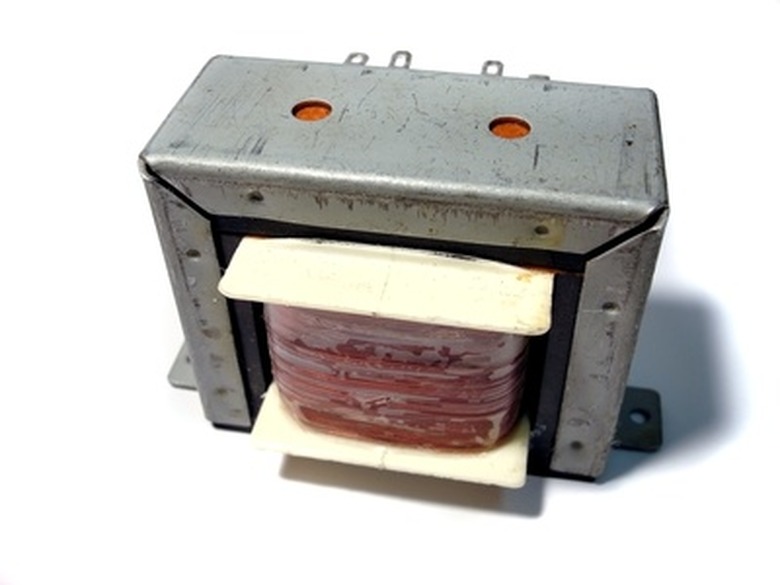How To Build A Simple Electrical Transformer For School
Transformers are simple devices, but they are also extremely important to our electrified way of life. Large transformers step up the voltage at the power stations so it can be transmitted more efficiently through power lines, and a step down transformer makes the electricity useful at each house served by the power station. Transformers in physics are used for a number of purposes in the lab.
A transformer consists of nothing more than a pair of wire coils, which can be wrapped around a common core or two cores placed side to side. Transformers work only with alternating current (AC), because they rely on electromagnetic induction, whereby a changing electric field produces a magnetic field, and vice versa.
It's easy to make a transformer for a school project, but you need to use it with a safe power source, and the 120V power coming from a wall plug isn't safe. One problem with transformers is that they get hot due to wire resistance, and if incoming voltage is too high, wires can get hot enough to burn you or start a fire. So building a safe power source is an important part of a project demonstrating the working of a transformer.
Use a Light Dimmer for Your Power Source
Use a Light Dimmer for Your Power Source
To construct a safe power source, you'll need a plastic electrical box, an old plug from an appliance you don't use anymore and a light dimmer switch, also known as a variac switch. Here's how to construct the power source (be sure to follow safety procedures when working with electricity!):
1. Cut the cord from the appliance and cut the cord in two. Set aside the part without the plug for later. Strip the plug wires with a wire stripper, exposing about an inch of bare wire on each. 2. Connect the plug wires to the input terminal of the switch. You don't have to worry about polarity. Use wire nuts to make the splice connections. 3. Strip both ends of the extra cord, separate the wires and connect one end of the cord to the switch output terminals. The other end provides the power input for the transformer. 4. Screw the switch into a plastic electrical box and feed the wires through the holes in the back of the box. 5. Set the switch to its lowest position and tape it in that position so you can't change it.
Constructing a Step Down Transformer
Constructing a Step Down Transformer
You need two main ingredients to make a transformer. The first is a steel core and the other is a lot of thin conducting wire. A 3- or 4-inch steel machine washer, available at hardware stores, makes a good core. The best wire to use is 28-gauge magnetic wire, which is coated with insulation. You can get this at any electronics supply store.
Make two separate windings on the coil. The more times you wind the coil, the better the transformer will work. Be sure to count the windings and keep track of the numbers – you'll need that information when you test the transformer.
To make a step-down transformer, the number of windings on the primary coil must be less than the number on the secondary coil. The voltage ratio will be equal to the ratio of the number of turns on the coils. For example, if the primary coil has 200 turns and the secondary coil has 100, the transformer will cut the incoming voltage in half.
Demonstrating the Working of a Transformer
Demonstrating the Working of a Transformer
Before you test your transformer, strip the ends of the wires and set the transformer in a 2-gang plastic electrical box for safety. Splice the wires of the primary coil to the wires coming from the switch. Separate the secondary coil wires to make sure they don't create a short when you connect power.
Plug in the transformer, set a multimeter to test AC voltage and check the voltage coming from the switch by touching the meter leads to the separated output wires. Now check the voltage coming from the secondary coil. Record your results.
Cite This Article
MLA
Deziel, Chris. "How To Build A Simple Electrical Transformer For School" sciencing.com, https://www.sciencing.com/build-simple-electrical-transformer-school-7842346/. 25 September 2019.
APA
Deziel, Chris. (2019, September 25). How To Build A Simple Electrical Transformer For School. sciencing.com. Retrieved from https://www.sciencing.com/build-simple-electrical-transformer-school-7842346/
Chicago
Deziel, Chris. How To Build A Simple Electrical Transformer For School last modified March 24, 2022. https://www.sciencing.com/build-simple-electrical-transformer-school-7842346/
